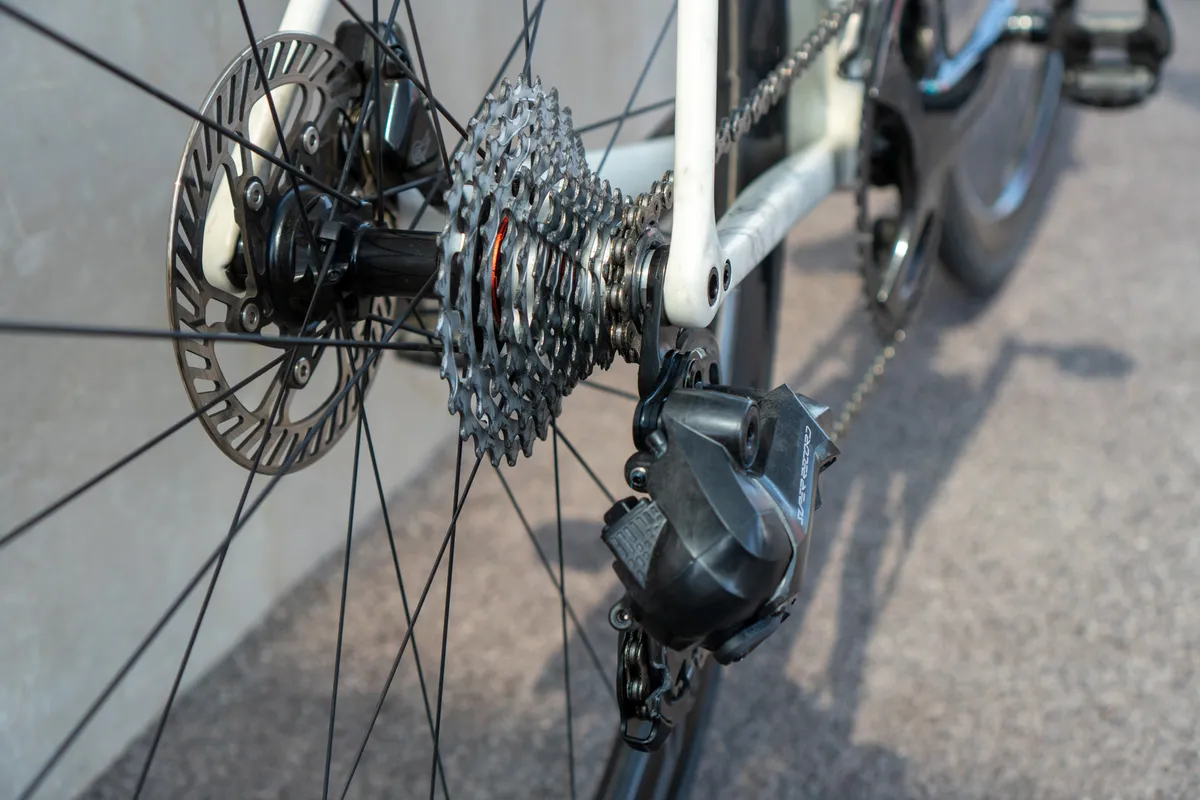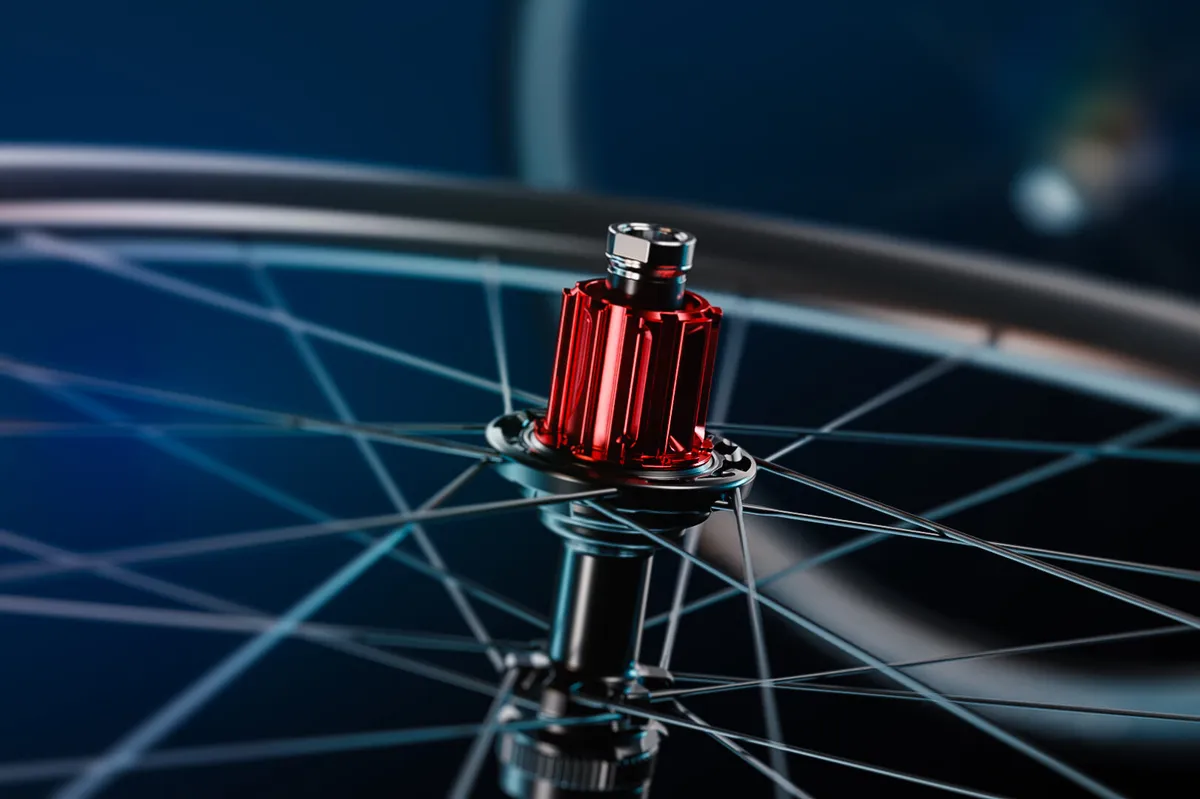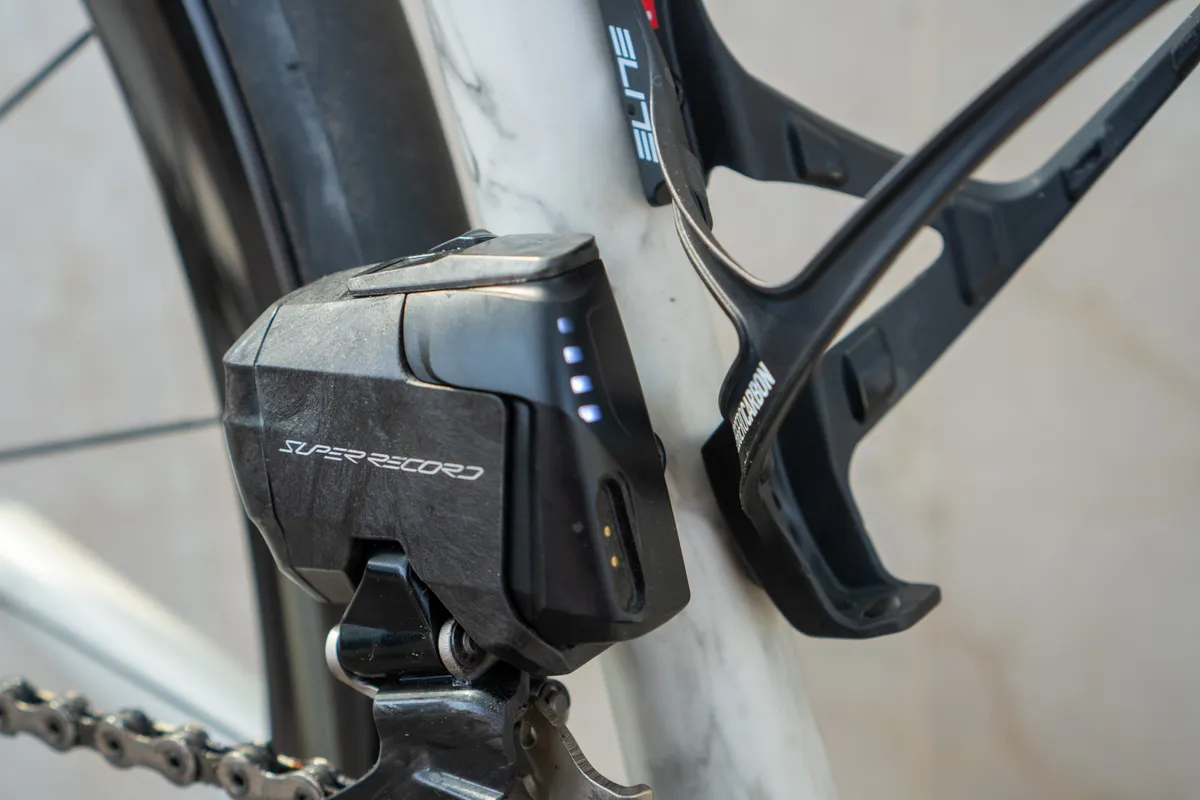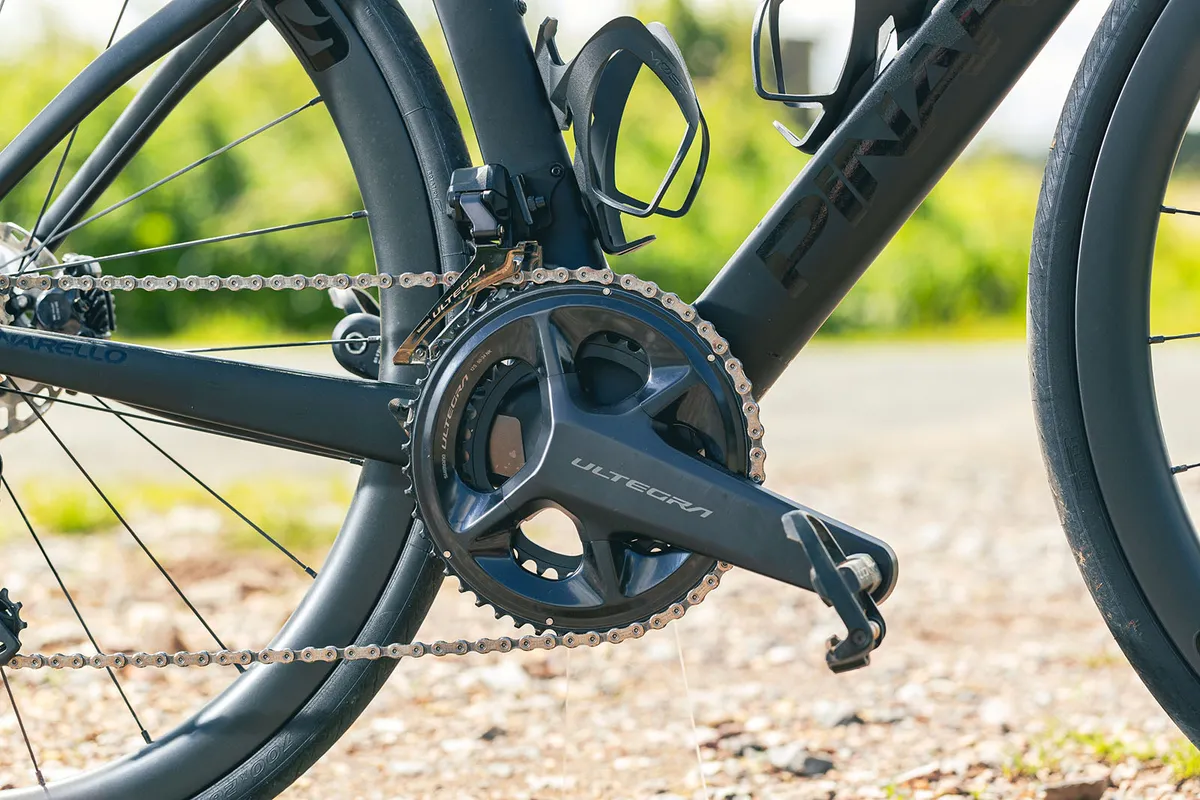Shimano Dura-Ace, SRAM Red AXS and Campagnolo Super Record Wireless are the flagship road bike groupsets from the three biggest manufacturers.
These are the most expensive road bike groupsets each brand produces, and the kit you’ll see sponsored WorldTour teams riding.
SRAM Red eTap AXS is the newest of the bunch, with the updated version released in May 2024. Its original release in 2019 ushered in the beginning of the AXS era for SRAM, which now extends to four road and gravel groupset tiers, as well as mountain bike groupsets.
Campagnolo Super Record Wireless was released in May 2023 and is also wireless.
Shimano Dura-Ace R9200 was released in 2021 and brought semi-wireless shifting to Shimano’s Di2 groupsets for the first time. It’s now the oldest of the three.
All three are 12-speed and are available exclusively as electronic groupsets – you can no longer buy a top-tier mechanical groupset from Shimano, Campagnolo or SRAM.
In this in-depth guide, we’ll compare the three brands’ premium groupsets – what each offers and how they function, as well as the all-important weights and prices.
Shimano, SRAM and Campagnolo shifters compared

The design of SRAM, Shimano and Campagnolo's shifters was, for many years, a key point of differentiation between each manufacturer.
However, with Campagnolo ditching its signature thumb shifter, all three now work in a broadly similar fashion.
Their ergonomics are more similar, too. While Shimano made its 12-speed shifter bodies larger than its previous generation 11-speed ones, SRAM has shrunken its new Red ones. Campagnolo has redesigned its shifter bodies to be more ergonomic as well.
As with Shimano, Campagnolo now has two shifter buttons on each brake lever. Shimano mounts its shifters one behind the other, while Campag’s are above and below each other.
Campagnolo’s My Campy 3.0 app allows the functionality of these to be custom-programmed.

Shimano’s older 11-speed Di2 shift buttons could be difficult to differentiate, particularly when wearing winter gloves. It’s gone some way to addressing this with its 12-speed shifters though, with the two shift buttons more widely separated and the forward shifter raised relative to the rear one. Shimano also integrates auxiliary buttons into the top of the hoods of its Dura-Ace shifters.

SRAM has just one shift button per brake lever, which makes rear gear changes more intuitive: right shifter to change up, left to change down in standard configuration.
Front changes are also straightforward. You operate both shift levers together to move between chainrings.
You can change what each Red shift button does, either using the AXS app or on the latest Hammerhead Karoo cycling computer, which comes included with the groupset. There’s a new Bonus Button on the hoods, mirroring Shimano’s hidden third button, which can be programmed to provide additional functions. Campagnolo doesn’t offer a third button.
Both SRAM and Shimano allow you to set up satellite shifters positioned elsewhere on your bars or bar extensions. SRAM’s Blips are wireless and you can link up to eight to your configuration. In contrast, Shimano’s are wired and you can only set up one pair. Campagnolo doesn’t offer satellite shifters.
Campagnolo and SRAM's wireless design vs Shimano's semi-wireless approach

Both Campagnolo Super Record Wireless and SRAM Red AXS groupsets are fully wireless.
As a result, setting up the front and rear derailleurs is an easier task than with wired electronic groupsets.
In contrast, Shimano Dura-Ace is semi-wireless.
Shimano’s front and rear derailleurs are connected to a central battery, which is usually located inside the seat tube. However, some brands including Cannondale are now choosing to mount the battery in the down tube as their seat tubes are now too skinny for the battery to fit.
The single battery makes setup slightly harder than Super Record Wireless or Red eTap AXS, but at least you won't need to route anything through the headset on an integrated bike.
That's unless you use the rim-brake version of the groupset, which is still wired.
Different gearing options

Shimano is now the only one out of the big three to stick with cassettes that start with an 11-tooth sprocket.
For a given gear range, this makes everything larger than starting at 10-teeth – you must use larger cassettes and larger chainrings to provide an equivalent top gear.
This could potentially mean more weight, although a comparison shows Shimano Dura-Ace weighs approximately the same as SRAM Red and Campagnolo Super Record.
Shimano says teh Dura-Ace cassettes are available in the following range:
- 11-28t
- 11-30t
- 11-34t
However, despite being promised at launch, the 11-28t cassette is still not commercially available.
Campagnolo has followed SRAM’s lead in starting with 10 teeth on its cassettes. It provides the following cassette options:
- 10-25t
- 10-27t
- 10-29t
SRAM Red offers a wider range of cassettes than Campagnolo:
- 10-28t
- 10-30t
- 10-33t
- 10-36t
The larger-range cassettes should allow fewer front shifts and lead to more efficient riding.
There’s now just one Red rear derailleur which works with all the available Red cassettes, all of which are available in rainbow anodised and standard metal finishes.
SRAM has redesigned its front derailleur with a cage that’s more tightly wrapped around the chain and which auto-trims as you move up and down the cassette, unlike the previous mechanism.
Wheel compatibility

When you're considering which road bike wheels will work with one of these three groupsets, you need to consider which freehub is on the wheels:
- Campagnolo cassettes: N3W freehub body
- SRAM Red cassettes: XDR freehub
- Shimano 12-speed cassettes: new 12-speed road freehub, though they're also backwards-compatible with HG-style freehubs
It's possible to change the freehub body on some wheels to fit cassettes from different groupsets.
Crankset options compared

You can choose between 50/34t, 48/32t and 45/29t Campagnolo Super Record chainrings.
As with the first generation 12-speed groupset, SRAM Red offers 50/37t, 48/35t and 46/33t double chainrings. So, although its large ring sizes are similar, its chainrings don’t provide such a big jump between the two rings as Campagnolo.
This compensates for Campagnolo’s more closely spaced cassettes and results in both groupsets offering a comparable gear range. With SRAM, you will need to make fewer front shifts, while with Campagnolo the jumps between gears are smaller at lower ratios.
If you like to push a big gear, you can buy a SRAM chainring set with 52/39t, 54/41t and 56/43t configurations. Campagnolo says it may produce larger chainrings to satisfy pro riders, too.

Shimano Dura-Ace cranksets provide 54/40t, 52/36t and 50/34t options, which along with its wide-ranging cassettes offer a much greater range than the Shimano pro-level groupsets of old.
SRAM Red chainrings are direct mounted and made as one piece, whereas Campagnolo and Shimano chainrings are interchangeable on the crank-arm spider.
SRAM, Shimano and Campagnolo all now have a double-sided power meter option for their double cranksets, following the launch of the Campagnolo HPPM power meter.
Unique among the three, SRAM also sells a single chainring aero option with a 48t or 50t chainring with or without a power meter.
Shimano has the most crank-length options, with SRAM second and Campagnolo last. SRAM now has a 160mm crank length available, but has discontinued its previous 177.5mm cranks.
Shimano Dura-Ace, SRAM Red and Campagnolo Super Record crank-length options compared
| 160mm | 165mm | 167.5mm | 170mm | 172.5mm | 175mm | 177.5mm | |
|---|---|---|---|---|---|---|---|
| Campagnolo Super Record Wireless | X | X | X | X | |||
| SRAM Red AXS | X | X | X | X | X | X | |
| Shimano Dura-Ace Di2 | X | X | X | X | X | X | X |
Disc brakes reign supreme

All three brands use hydraulic disc brakes for their top-spec road bike groupsets. This should come as no surprise – many of the best road bikes are now disc-brake only.
Shimano offers a get-out rim brake configuration for the die-hards, but both SRAM and Campagnolo have gone all-in on disc brakes.
Campagnolo says its disc brakes are efficient enough to avoid excessive heat build-up without resorting to cooling fins on the disc brake rotors.

That’s true, too, of SRAM’s HRD brakes, which have been redesigned for a lighter action with more leverage and increased pad separation for less chance of brake squeal or ticking.
Shimano Dura-Ace disc brakes rotors incorporate a cooling fin and you can spec pads with cooling fins as well. Shimano says this Freeza tech helps to reduce rotor heat by up to 100°C.
All three brands offer reach adjustment at this top-spec level. Unlike SRAM and Shimano, Campagnolo doesn’t offer bite-point adjustment.
Battery life

Campagnolo quotes a 750km derailleur battery range with heavy use, or up to 1,000km with less intensive shifting, which is similar to Shimano’s claimed 1,000km.
Confusingly, SRAM quotes in hours: 60 of them.
SRAM’s system means you can swap batteries between derailleurs if the rear derailleur battery gives up.
That’s not an option with Campagnolo because the battery shapes are different, so you’ll need to struggle home with a single rear ratio if you’ve forgotten to charge up before your ride.
Shimano’s single battery prioritises rear shifting if it’s short on juice, so its get-me-home functionality is an advantage over Campagnolo’s. You also get some warning of the low battery once the front derailleur gives up, even if you haven’t paid attention to the flashing low battery LED.
All three systems use coin cells to power the shifters and all three claim around a two-year battery life.
Charging

Campagnolo has the upper hand over its rivals with its charging tech, because it offers both on-bike and off-bike charging, thanks to a magnetic charging interface.
In contrast, Shimano’s internal battery is only chargeable on-bike via the magnetic charge port in the rear derailleur, so you need a wall socket nearby to connect the charger.
SRAM only offers off-bike charging via its USB docking station. This has the advantage that you can take your batteries somewhere convenient to charge, but the disadvantage of having to unhook the batteries from your derailleurs every time you need to charge them.
In reality, this isn’t such an arduous task and both SRAM’s optional four-battery charger and its single-battery charger that comes with the groupset do the job in double-quick time via USB-C. A full charge is claimed to take 60 minutes.
Campagnolo also offers fast charging, claiming a 90 per cent charge in 45 minutes and a full charge in 60 minutes. The quoted time for a full recharge of a Shimano Di2 battery is between 1.5 and 3 hours.
Shimano Dura-Ace, SRAM Red and Campagnolo Super Record weights compared

New SRAM Red has a claimed weight of 2,496g for a 48/35t power meter with a 10-28t cassette, all the required bolts and bits and even the hydraulic fluid, with SRAM claiming that it’s now the lightest groupset of the trio.
That’s borne out by the 2,520g claimed weight for the Super Record Wireless groupset 2,520g in its lightest configuration without a power meter.
Meanwhile, we weighed Shimano Dura-Ace at 2,514g when we tested it, but that did include a power meter.
As always, actual weight is highly dependent on configuration and whether you include the small parts such as Shimano’s battery mounting kit and rotor lockrings. However, weight-wise SRAM does appear to have the upper hand now, even if only by a few grams.
High prices

If you want a pro-level groupset, you’re going to pay for it, regardless of which brand you choose.
As with weight, price is highly dependent on the options chosen, but a complete Shimano Dura-Ace groupset costs around £3,600 at full retail price.
A complete SRAM Red groupset is less expensive, at around £3,000 without a power meter, although SRAM does include a Hammerhead Karoo cycling computer.
Discounting does mean you can usually buy groupsets for a significantly lower price though, at least for SRAM and Shimano.
Meanwhile, Campagnolo Super Record retails for €5,200, or around £4,500. If you want an in-series Campagnolo HPPM power meter, you can add £1,990 to that for a total just shy of £6,500 – slightly more than a complete Shimano Ultegra-equipped Canyon Ultimate CF SLX 8 Di2 with DT Swiss carbon wheels.
Cheaper options

Talking of Ultegra, both SRAM and Shimano offer cheaper electronic-shifting road bike groupsets, alongside their premium groupset.
In SRAM’s case, its AXS groupsets are available at Force, Rival and Apex levels. Force and Rival offer double and single chainring options, while Apex is single ring only.
Shimano has Ultegra and 105 Di2 as less expensive electronic road bike groupsets.
The wireless Campagnolo groupset, as with its predecessor wired version, continues to be offered at Super Record level only. Campagnolo formerly offered wired electronic shifting at Record and Chorus level though, and it hinted to us at launch that its new wireless tech may trickle down in future.
undefinedundefinedundefinedundefined
